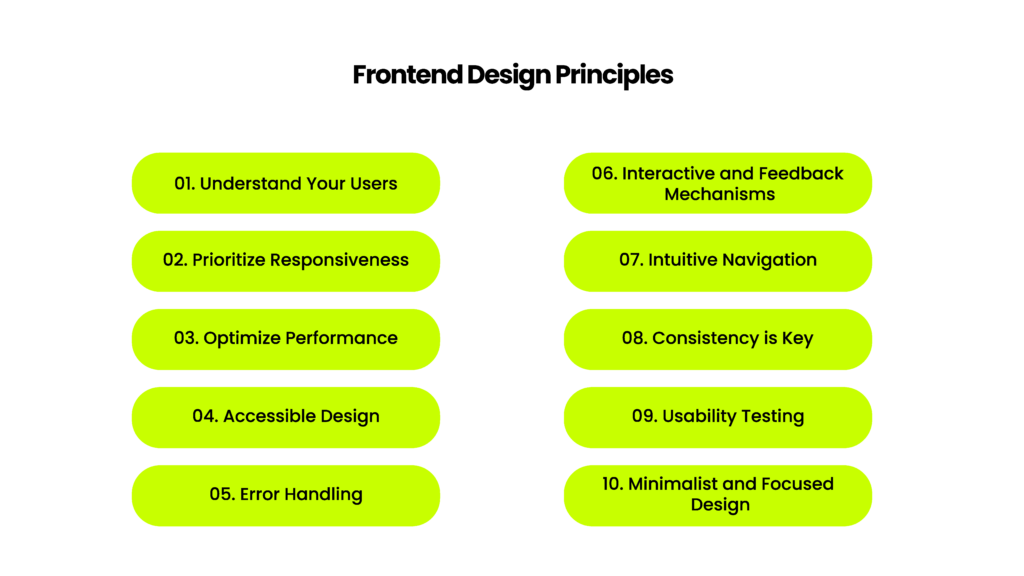In today’s modern web development world, providing a better user experience is crucial in order to keep your users navigating your site. With users interacting with a vast array of applications daily, the quality of the user experience you offer becomes an important factor in determining your platform’s success. Prioritizing user experience is no longer optional, it’s essential for the success of your web application.
While the backend handles the data and logic of the application, the frontend is the user’s gateway, where complexed processes are translated into a visually engaging and accessible interface. However, creating a frontend that truly enhances the user experience requires more than just technical knowledge, it demands a deep understanding of design principles and user behavior.
This article delves deep into discussing the frontend design principles and explores all benefits obtained from following such principals. Whether you’re building a new application from scratch or rebuilding an existing one, these principles will guide you in creating a frontend that resonates with users, ensuring that your application stands out in a crowded marketplace.
Understanding the Importance of User Experience

User Experience is the heart of every successful digital product on the market. It encompasses every aspect of how users interact with an application, from the initial impression to the final action. A positive user experience is important because it directly affects the user’s decision on choosing your platform and their first impression of your application.
In today’s competitive market, alternatives for your platform are a click away. A poor user experience can lead to frustration, abandonment, and negative word-of-mouth. For example, consider a website that operates correctly but suffers from slow load times. This can result in user dissatisfaction, prompting users to seek out other platforms that offer a better experience. Ensuring optimal performance and user satisfaction is crucial to retaining users and maintaining a competitive edge.
Benefits of Enhancing User Experience in an Application
- Increased User Satisfaction
- A positive user experience ensures that users find the application enjoyable and easy to use, leading to higher satisfaction and positive feedback.
- Higher User Engagement
- A website rich in user experience encourages users to spend more time interacting with the application and exploring its features.
- Greater Conversion Rates
- Enhanced user experience of a web application makes it easier for users to complete desired actions on your site.
- Positive Brand Perception
- A user-friendly and visually appealing application enhances the overall brand image, building trust and differentiating your brand from all other competitors on the market.
- Increased Search Engine Rankings
- A better user experience, with faster loading pages, can boost your search engine rankings. This helps your site attract new users more easily by making it more visible in search results..
Frontend Design Principles

Understanding frontend design principals could highly benefit a frontend developer to provide a better user experience on their web application. Following are some of the common core principles of frontend design that can enhance UX in full stack applications.
1. Understand your Users
Understanding your users is the first step in producing quality user experience. Knowing who they are, their goals, challenges, expectations and how they interact with your application will guide your design decisions. Collecting a proper user requirement before getting started could possibly help in making decisions and arriving at conclusions. Additionally, tools like user personas, user journey mapping, and usability testing are invaluable in gaining these insights.
2. Prioritize Responsiveness
A responsive website will make a huge impact on the user experience of your site. Your design should seamlessly adapt to various screen sizes, from mobile phones to desktops. Techniques such as media queries, fluid grids, flexible images are essential in creating a responsive design. Additionally, you could consider touch-friendly elements for mobile users to enhance accessibility on your web application.
3. Optimize Performance
Fast-loading pages are crucial for a good user experience in web applications. While eye-catching designs and animations can make your site look great, they lose their impact if the site loads slowly. The main goal should be to improve performance, making sure everything on your site loads quickly, especially for users with slower internet connections. By doing this, you can enhance the user experience and attract more users to your platform.
4. Accessible Design
Accessibility is something that is very important to be included in today’s modern web applications. With users interacting with a lot of applications daily, it is our responsibility as frontend developers to ensure that our web applications are accessible to everyone, including individuals with disabilities. Implementing features like keyboard navigation, screen reader support, and high-contrast modes could help you achieve your goal. Additionally, it is important to follow the Web Content Accessibility Guidelines to ensure your application meets accessibility standards.
5. Error Handling
Handling all possible errors that could occur in your application can significantly impact the user experience of your web application. By Displaying proper error messages, keeping your users notified about what has gone wrong and providing guidelines on how to proceed further would significantly enhance the user experience of your application. Additionally, avoiding technical jargon and using friendly language to display messages would help you achieve your goal.
6. Interactive and Feedback Mechanisms
Providing real time feedback for user actions is something that could enhance user experience of your application. Whether it’s a loading spinner, confirmation message, or error alert, users need to know that their actions are acknowledged. Consider a scenario where a user clicks a button, the action is executed, but there is no feedback provided about the outcome. This lack of communication can significantly diminish the user experience, potentially leading to user dissatisfaction. As software developers, it is essential to anticipate and prevent such situations by ensuring that users receive clear and immediate feedback, thereby enhancing the overall user experience and satisfaction. In addition to providing automated feedback, it’s also smart to invite users to share more detailed, qualitative input through tools like Typeform. This helps you gather valuable insights directly within the app while keeping the experience smooth and uninterrupted.
7. Intuitive Navigation
Navigating your site should be a user friendly action to perform. Users should be able to move through the application effortlessly making navigation easy to understand. Properly desinged navigations bars with breadcrumbs to guide users could significantly enhance the user experience of you web application. Additionally, avoid overwhelming users with too many options at once. Instead, prioritize key actions and use progressive disclosure to reveal more options as needed.
8. Consistency is Key
Maintaining consistency across your application is the key for enhancing the user experience. This includes, proper use of colors, fonts and layout structure. A style guide or design system can help maintain consistency, ensuring that every component aligns with the overall design language of your application.
9. Usability Testing
Every design must go through usability tests in order to ensure your application is meeting the user expectations. Regular testing with real users provides insights into how your application performs in the real world. Using the gathered feedback, the developer can adapt the design ensuring that it meets the expectations of all users.
10. Minimalist and Focused Design
Keeping the design minimal could add more richness to your application. A minimalist design focuses on essential elements, reducing clutter and distractions leading to an enhanced user experience. Additionally, it is important to ensure that each design element should have a purpose, and is contributing to the overall user experience of the application.
Conclusion
In full stack development, the frontend is where the user interacts with the application, making it an important component of the user experience. By following these design principals you can create applications that are not only functional but also delightful to use. The user experience is what decides to keep or loose your customers from continuing to navigate your website. Enhancing the user experience could open a wide door of possibilities that would benefit you in many ways. Remember, a great user experience is a journey, not a destination, so keep testing, iterating, and evolving your design to meet the needs of your users.
FAQs
What are the key principles of frontend design for enhancing user experience?
- Focus on usability, accessibility, responsive design, consistency, and performance to create a seamless user experience.
How does responsive design impact user experience in full stack applications?
- Responsive design ensures your application looks and functions well on all devices, improving overall user satisfaction.
Why is accessibility important in frontend design?
- Accessibility ensures that all users, including those with disabilities, can interact with your application, broadening your audience.
How can I improve web performance in my frontend design?
- Optimize images, minify code, and reduce server requests to enhance loading speeds and user experience.
What role does UI/UX play in frontend design for full stack applications?
- UI/UX design focuses on creating intuitive interfaces and smooth interactions, which are crucial for user engagement and satisfaction.








